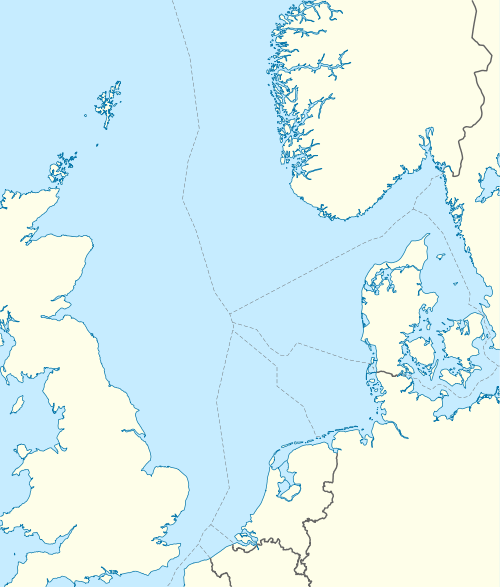Sleipner gas field
| Sleipner gas field | |
|---|---|
 | |
 Location of Sleipner gas field | |
| Country | Norway |
| Region | North Sea |
| Block | 15/6, 15/8, 15/9 |
| Offshore/onshore | Offshore |
| Coordinates | 58°22′N 1°55′E / 58.36°N 1.91°ECoordinates: 58°22′N 1°55′E / 58.36°N 1.91°E |
| Operator | Statoil |
| Partners |
Statoil ExxonMobil Total S.A. |
| Field history | |
| Discovery | 1974 |
| Production | |
| Current production of gas | 36×106 m3/d (1.3×109 cu ft/d) |
| Year of current production of gas | 2005 |
| Estimated gas in place | 51.6×109 m3 (1.82×1012 cu ft) |
The Sleipner gas field is a natural gas field in the North Sea, about 250 kilometres (160 mi) west of Stavanger, Norway. Two parts of the field are in production, Sleipner West (proven in 1974), and Sleipner East (1981).[1][2] The field produces natural gas and light oil condensates from sandstone structures about 2,500 metres (8,200 ft) below sea level. It is operated by Statoil. The field is named after the steed Sleipnir in Norse mythology.
Reserves and production
As of the end of 2005, the estimated recoverable reserves for the Sleipner West and East fields were 51.6 billion cubic metres of natural gas, 4.4 million tonnes of natural gas liquids, and 3.9 million cubic metres of condensates.[1][2] Daily production of the field in 2008 was 300 thousand barrels per day (48×103 m3/d) equivalents, 36 million cubic metres of natural gas per day, and 14,000 cubic metres of condensate per day.
Sleipner field consists of four platforms. The Sleipner A platform is located on the Sleipner East and the Sleipner B platform is located on the Sleipner West. Sleipner B is operated remotely from the Sleipner A via an umbilical cable. The Sleipner T carbon dioxide treatment platform is linked physically to the Sleipner A platform by a bridge and to the Sleipner B wellhead platform by 12.5-kilometre (7.8 mi) carbon dioxide flow line.[3][4] The Sleipner Riser platform, serving the Langeled and Zeepipe pipelines, is located on the Sleipner East field.
Carbon capture and storage project
The Sleipner West field is used as a facility for carbon capture and storage (CCS).[5][6] It is the world's first offshore CCS plant, operative since October 1996.[7] Carbon dioxide is treated on the Sleipner T treatment platform. After that carbon dioxide is transported to the Sleipner A platform where it is injected into the Utsira formation through a dedicated well ca. 1000 meters under the seabed.[4] Norwegian natural gas pipelines' operator Gassco has proposed to build a 240-kilometre (150 mi) carbon dioxide pipeline from Kårstø to transport carbon dioxide from the Kårstø power station.[8]
See also
References
- 1 2 "Sleipner West". Scandinavian Oil-Gas Magazine. 2007-07-28. ISSN 1500-709X. Retrieved 2009-12-26.
- 1 2 "Sleipner East". Scandinavian Oil-Gas Magazine. 2007-07-28. ISSN 1500-709X. Retrieved 2009-12-26.
- ↑ "Statoil shuts Sleipner B, transit intact". Reuters. 2009-12-18. Retrieved 2009-12-26.
- 1 2 "Sleipner Project". IEA Greenhouse Gas R&D Programme. Retrieved 2009-12-26.
- ↑ Haugan, Bjørn-Erik (2005). "Technology as a driving force in climate policy". Cicerone. Oslo: Center for International Climate and Environmental Research (6): 8–9. Retrieved 2009-12-26.
- ↑ "Oil group buries greenhouse gas under sea". Reuters. CNN. 2003-11-19. Retrieved 2009-12-26.
- ↑ "Sleipner Vest". Statoil. 2007-08-20. Retrieved 2009-12-26.
- ↑ Vibeke Laroi (2009-11-19). "Gassco Will Propose Pipeline to Transport C02 From Kaarstoe". Bloomberg. Retrieved 2009-12-26.
